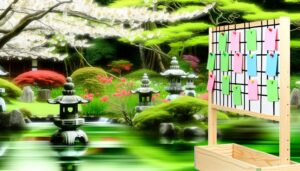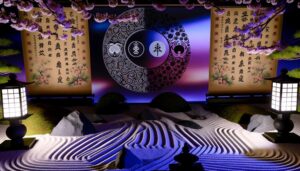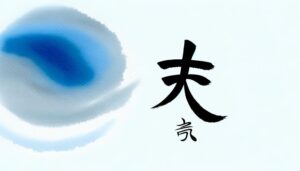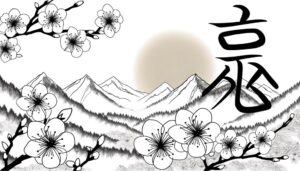What Is the Japanese Symbol for Fire?火
The Japanese symbol for fire is represented by the Kanji character “火” (hi or ka). This character carries deep significance, symbolizing energy, passion, and transformation.
Historically, it has roots in ancient Japan, appearing in early scripts and texts. In cultural contexts, the fire symbol is linked to Shinto beliefs and traditional ceremonies, embodying the impermanence of life and the force of nature.
Its representation extends into modern times, featured in contemporary designs and popular culture to signify determination and intensity. There is much more to explore about its rich historical origins and cultural significance.
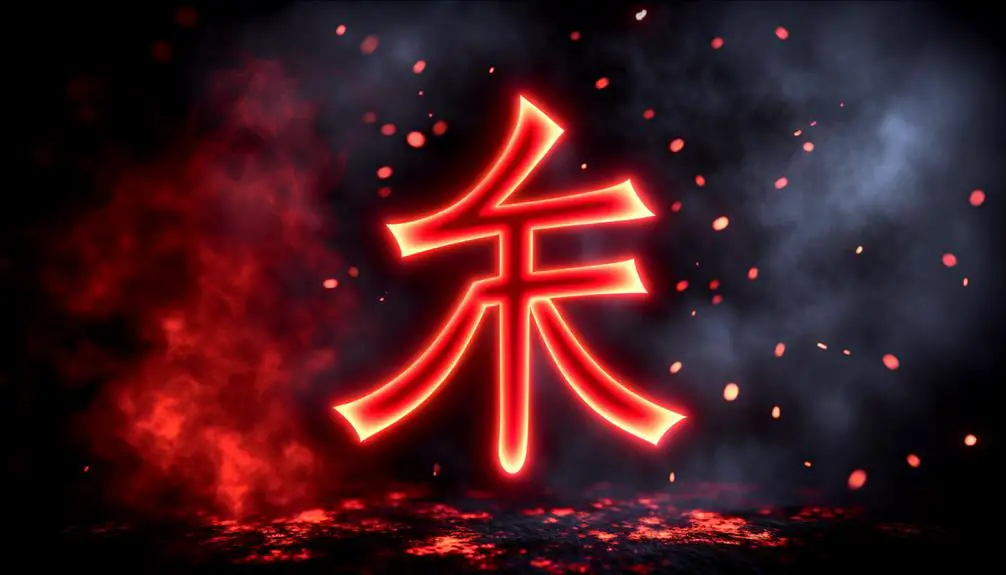
Key Takeaways
- The Japanese symbol for fire is 火.
- It represents energy, passion, and transformation in Japanese culture.
- Used in traditional ceremonies and Shinto beliefs, symbolizing purification and renewal.
- Found in Japanese art, literature, and modern designs, symbolizing strength and resilience.
- The symbol 火 is associated with the element of fire and the impermanence of life.
The Kanji Character for Fire
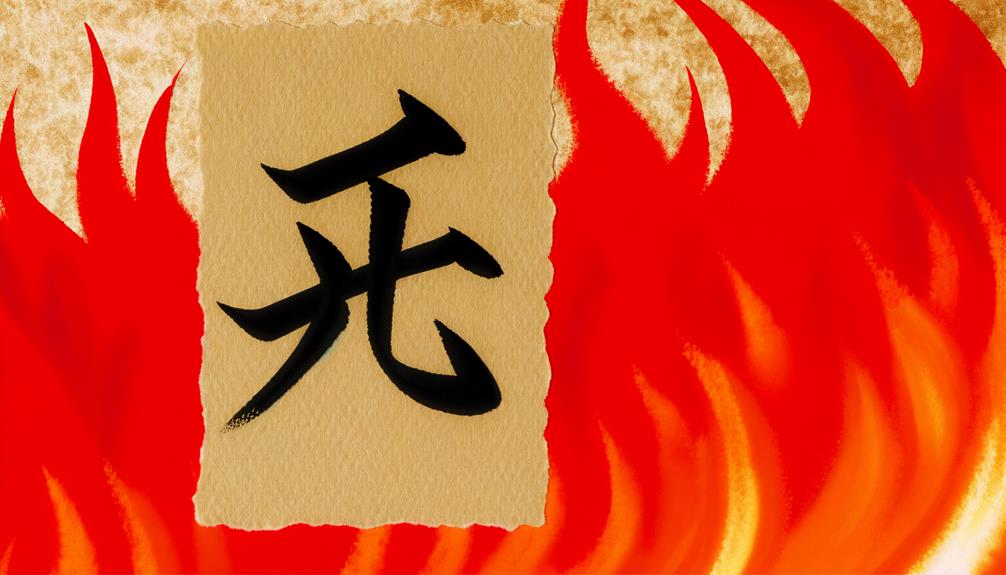
The kanji character for fire, 火 (hi or ka), is a fundamental symbol in the Japanese language, deeply rooted in the country’s history and culture. This character is not merely a linguistic element but also a representation of one of the pivotal natural elements in Shintoism and Japanese folklore.
Historically, fire has held significant importance in various cultural practices, from ritual purification to agricultural festivals. The character itself is visually evocative, resembling flames or a bonfire, which reflects its inherent meaning. Moreover, 火 is integral to many compound words and expressions, enhancing its linguistic versatility.
Its presence in daily life, literature, and symbolic contexts underscores its deep-seated influence on Japanese societal norms and traditions.
Pronunciation and Meaning
Pronounced as ‘hi’ in its most basic form, the kanji character 火 embodies the concept of fire, denoting both its literal and metaphorical significance in Japanese culture. Beyond its elementary pronunciation, this multifaceted symbol can take on various readings and meanings depending on context. Its application ranges from describing physical flames to symbolizing passion, energy, and transformation. Below is a table summarizing different readings and associated meanings:
| Pronunciation | Meaning |
|---|---|
| hi | Fire (basic) |
| ka | Fire (in compounds) |
| bi | Flame (formal) |
| honō | Blaze |
| en | Flame (archaic/poetic) |
Understanding these nuances allows for a richer appreciation of how this elemental kanji permeates both language and life in Japan.
Historical Origins
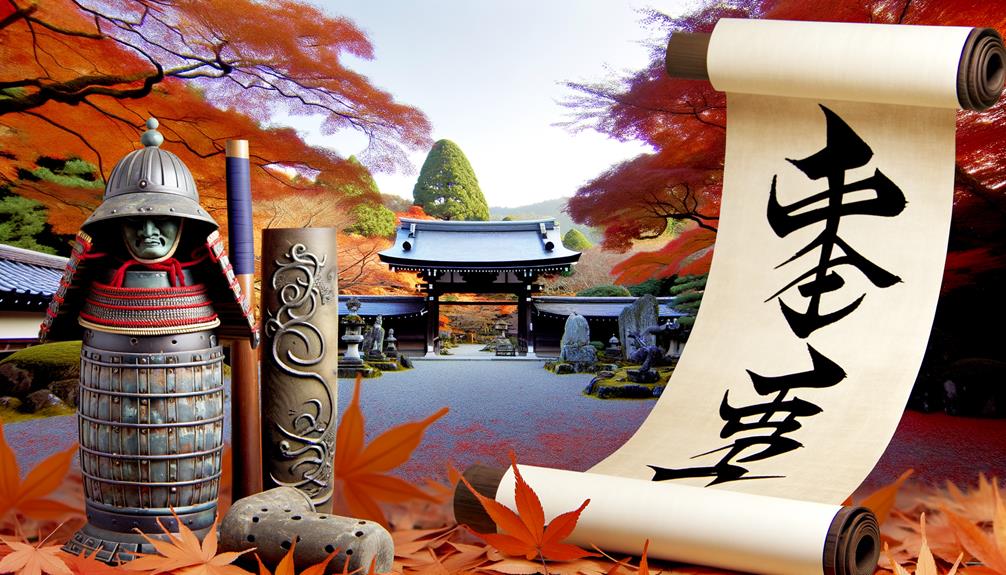
The historical origins of the Japanese symbol for fire, depicted as 火 (hi), trace back to the early development of kanji characters, which were adapted from ancient Chinese script.
This symbol has been deeply ingrained in Japanese culture, representing not only physical fire but also embodying profound symbolic significance in various aspects of life, including rituals and mythology.
Understanding its evolution offers insights into the broader cultural and linguistic exchanges between Japan and China.
Early Kanji Development
Tracing its roots back to ancient China, the early development of kanji reveals a complex and fascinating history that greatly influenced Japanese written language. Originating from Chinese characters, kanji were adopted and adapted by the Japanese during the 5th century.
This integration process involved:
- Borrowing Characters: Japanese scholars initially borrowed Chinese characters to represent native Japanese words.
- Phonetic Use: Kanji were sometimes used phonetically to approximate the sounds of Japanese speech.
- Semantic Adaptation: Over time, kanji were adapted to fit the unique linguistic and cultural context of Japan.
- Creation of New Characters: New characters, known as kokuji, were created to express concepts unique to Japanese culture.
This historical evolution underscores the intricate relationship between kanji and the Japanese language.
Symbolic Cultural Significance
Understanding the historical origins of kanji reveals how these characters, such as the symbol for fire (火), acquired deep cultural significance in Japanese society. Introduced from China, kanji were adapted to fit the Japanese language, intertwining with local myths and traditions.
The symbol for fire, 火, embodies not only its literal meaning but also represents energy, transformation, and purification. In ancient Japan, fire was pivotal for survival, used in cooking, heating, and religious rituals. The reverence for fire is evident in ceremonies like the Gozan no Okuribi, where large bonfires are lit on mountainsides.
This cultural integration of 火 underscores its role as a powerful and enduring element within Japanese heritage, reflecting both its practical and symbolic importance.
Cultural Significance
How does the Japanese symbol for fire encapsulate significant cultural meanings and historical importance?
The kanji for fire (火) is not just a character but a repository of rich cultural connotations and historical narratives. Fire, or ‘hi’ in Japanese, has been pivotal in shaping various aspects of Japanese life, from rituals to daily activities.
To explore further:
- Agriculture: Fire was essential for slash-and-burn agriculture, which played a vital role in ancient farming.
- Ceremonial Uses: Fire is central to numerous Shinto rituals, symbolizing purification and renewal.
- Craftsmanship: Traditional crafts like pottery and metalworking rely heavily on fire for creation and transformation.
- Safety and Community: Historical festivals, such as the Gozan no Okuribi, use fire to foster communal bonds and guarantee safety.
This multifaceted symbol continues to resonate deeply within Japanese culture.
Fire in Japanese Mythology
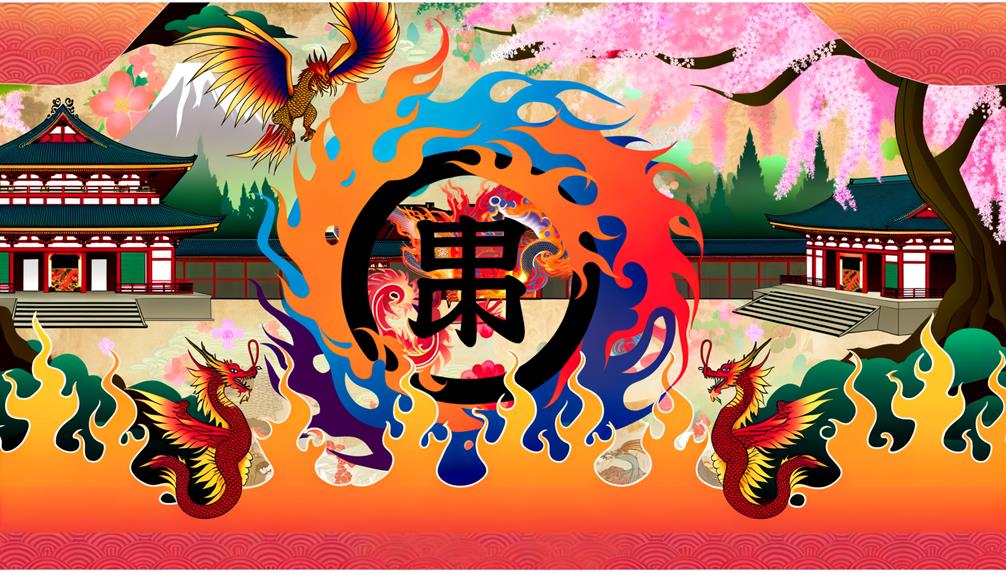
The cultural significance of fire in Japan extends beyond practical applications and rituals, finding profound expression in the domain of mythology where it is revered as both a creative and destructive force.
In Japanese mythology, fire is embodied by the god Kagutsuchi, born from the union of the primordial deities Izanagi and Izanami. Kagutsuchi’s birth was so intense that it caused the death of his mother, Izanami, highlighting fire’s destructive potential.
However, the myths also illustrate fire’s creative aspects, as Kagutsuchi’s flames gave rise to various deities and phenomena. Fire’s dual nature underscores its integral role in the cosmic balance, reflecting the delicate interplay between creation and annihilation within Japanese mythological narratives.
Modern Uses of the Symbol
In contemporary Japan, the symbol for fire (火) manifests in various facets of daily life, from its presence in language and literature to its use in design and technology. This symbol, rich in cultural significance, continues to hold relevance today through multiple avenues:
- Language: The kanji 火 is integral in words related to heat and energy, such as 火曜日 (Tuesday) and 火山 (volcano).
- Safety Signage: It is prominently displayed on fire safety equipment and emergency exits.
- Technology: The symbol is used in graphical user interfaces to denote functions like heating or activation.
- Fashion and Design: Frequently appears in modern aesthetics, symbolizing passion and transformation.
These modern uses underscore fire’s enduring importance in Japanese society, reflecting both tradition and innovation.
Fire in Japanese Art
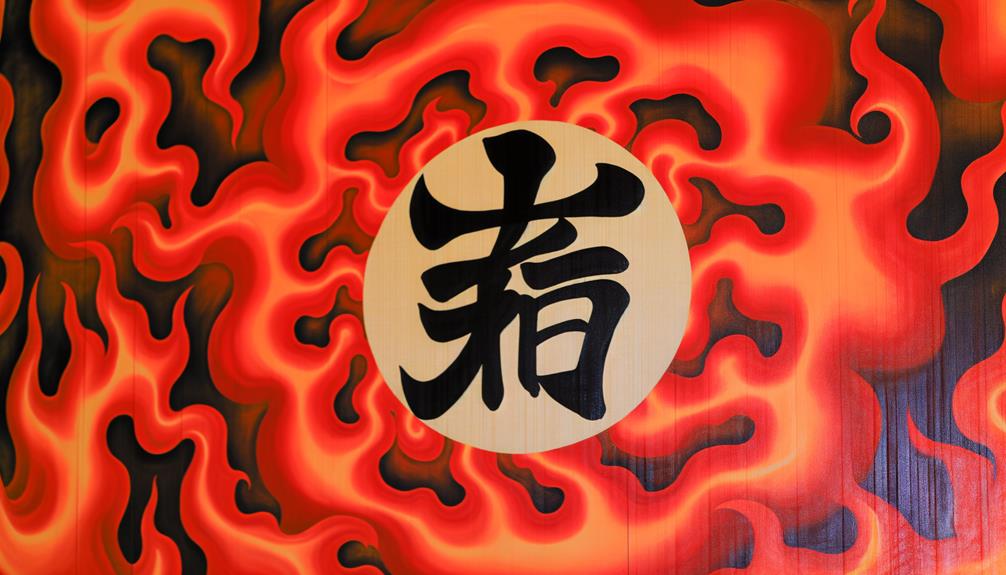
In Japanese art, fire is a potent symbol that has been portrayed in various forms across different historical periods. Traditional fire imagery often draws from mythological and religious contexts, while the symbolism in fire art can convey themes of destruction, purification, and rebirth.
Modern representations continue to evolve, reflecting contemporary interpretations and the enduring significance of fire within Japanese culture.
Traditional Fire Imagery
Traditional Japanese art frequently employs fire imagery to symbolize transformation, renewal, and the ephemeral nature of existence. This imagery is not merely decorative; it carries profound cultural and philosophical significance.
Artists often use fire to convey deeper meanings, including:
- Impermanence: Fire represents the transient nature of life, highlighting the importance of living in the moment.
- Purification: Fire is a purifying force, cleansing impurities and facilitating spiritual renewal.
- Destruction and Creation: Just as fire destroys, it also paves the way for new beginnings, symbolizing cycles of destruction and rebirth.
- Energy and Vitality: Fire embodies dynamic energy and life force, reflecting the vigor and resilience inherent in nature and human spirit.
Such symbolism enriches the artistic narrative, offering viewers multiple layers of interpretation.
Symbolism in Fire Art
Evoking both reverence and introspection, fire in Japanese art serves as a profound symbol interwoven with themes of transformation, purity, and the cyclical nature of existence.
Artists adeptly use fire to convey the ephemeral beauty of life, capturing moments of intense change and renewal. Traditional paintings often depict fire as a cleansing force, purging impurities and heralding new beginnings.
In sumi-e ink paintings, the depiction of fire is minimalist yet powerful, emphasizing its role in the natural order. Additionally, fire is frequently illustrated in connection with mythological tales, such as the story of Amaterasu, the sun goddess, highlighting its divine and purifying qualities.
Therefore, fire remains a central motif, symbolizing both destruction and the promise of renewal.
Modern Fire Representations
Building upon its rich historical symbolism, contemporary Japanese artists continue to explore the multifaceted representations of fire, incorporating modern techniques and perspectives to reflect current societal themes and personal introspections.
This dynamic interpretation of fire in contemporary art manifests through various mediums, each revealing unique insights:
- Digital Art: Utilizes advanced software to create vivid, fluid depictions of fire, symbolizing technological advancement and the volatile nature of digital communication.
- Installation Art: Engages viewers interactively, often using actual flames or light to evoke the transient beauty and destructive power of fire.
- Mixed Media: Combines traditional and modern materials, reflecting the convergence of past and present in Japanese culture.
- Abstract Expressionism: Uses fire as a metaphor for emotional intensity and existential exploration, presenting it through bold, non-representational forms.
Symbolism in Calligraphy
In Japanese calligraphy, the symbol for fire (火) is meticulously crafted to embody the dynamic and transformative nature of the element it represents. The strokes of the character are drawn with deliberate fluidity and intensity, mirroring the flickering and unpredictable movement of flames.
This artistic representation is not merely an aesthetic choice but a profound expression of the philosophical and cultural significance of fire in Japanese tradition. Fire symbolizes both destruction and renewal, a duality captured in the boldness and grace of the calligraphic strokes.
Each line is imbued with meaning, reflecting the balance of energy and tranquility, illustrating how calligraphy transcends mere writing to become a meditative practice that communicates deeper truths about the natural world.
Fire in Traditional Festivals
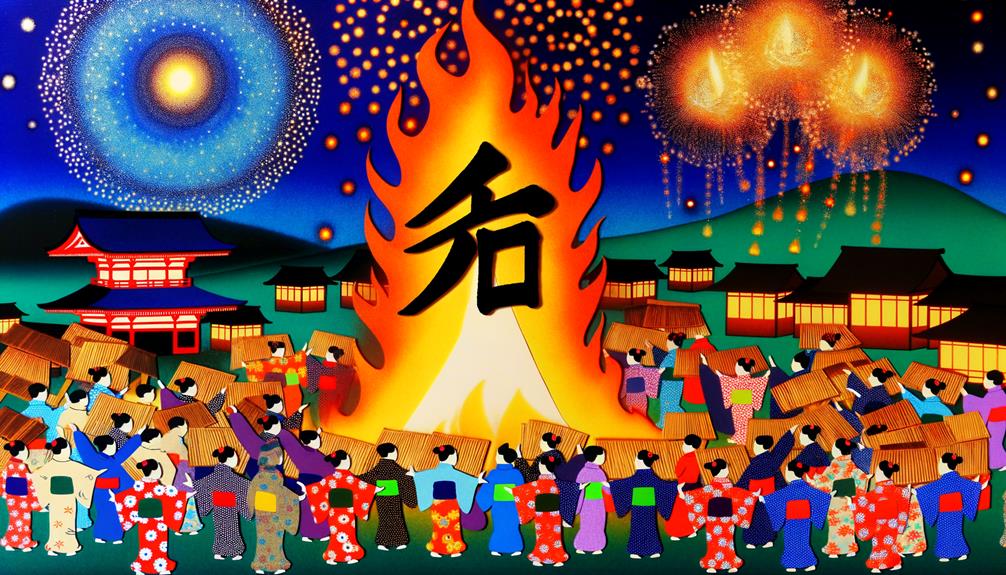
Fire plays a significant role in numerous traditional Japanese festivals, symbolizing purification and the presence of deities.
Fire dance rituals, the illumination of lanterns, and the lighting of bonfires are integral to these celebrations, each carrying profound cultural meanings.
Sacred flame ceremonies further highlight the spiritual importance of fire, linking past traditions with contemporary practices.
Fire Dance Rituals
Traditional Japanese festivals often feature enthralling fire dance rituals that blend ancient spiritual practices with vibrant cultural expressions. These enchanting performances serve multiple purposes, from honoring deities to celebrating seasonal changes. The intricate choreography and symbolism in these rituals can be understood through several key facets:
- Shinto Influence: Fire dances often have roots in Shinto practices, invoking purification and protection from malevolent spirits.
- Seasonal Celebrations: Many fire dances are integral to festivals marking the shifts of seasons, particularly in agricultural communities.
- Community Bonding: These rituals foster communal unity, as participants and spectators alike engage in the collective experience.
- Artistic Expression: The elaborate costumes, music, and choreography showcase the rich artistic heritage of Japan.
Understanding these elements provides deeper insight into the cultural significance of fire dance rituals.
Lanterns and Bonfires
Beyond the enchanting fire dance rituals, lanterns and bonfires play an equally significant role in traditional Japanese festivals, illuminating the night with their glowing presence and enriching the cultural tapestry.
Lantern festivals, such as Obon and Toro Nagashi, involve the release of lanterns onto rivers, symbolizing the guiding of ancestral spirits.
Bonfires, prominent in festivals like Gozan no Okuribi, create a mesmerizing spectacle as massive characters are set ablaze on Kyoto’s mountains, signifying the departure of spirits.
These fiery elements not only serve as visual spectacles but also hold profound cultural and spiritual meanings, embodying the Japanese reverence for fire as a purifying and guiding force.
Through these traditions, fire continues to unify communities and celebrate heritage.
Sacred Flame Ceremonies
Among the myriad of traditional Japanese festivals, sacred flame ceremonies stand out for their profound spiritual significance and intricate rituals. These ceremonies utilize fire not merely as a physical element but as a conduit for spiritual purification and communal bonding. Here are key aspects that highlight their importance:
- Ritual Purification: Fire is believed to cleanse impurities, symbolizing renewal and divine protection.
- Cultural Heritage: Such ceremonies preserve ancient customs, passed down through generations, enhancing cultural continuity.
- Community Unity: Participation fosters a sense of belonging and collective identity among community members.
- Symbolic Representation: Fire embodies transformation and the presence of the divine, reinforcing its spiritual essence.
Thus, sacred flame ceremonies encapsulate the spiritual depth and cultural richness of Japanese traditions.
Fire in Japanese Language
The Japanese symbol for fire, 火 (hi or ka), is a fundamental kanji character that holds significant cultural and linguistic importance.
In the Japanese language, 火 is not only used to represent the physical element of fire but also symbolizes energy, passion, and transformation. It appears in various compound words, such as 火曜日 (kayōbi, Tuesday) and 花火 (hanabi, fireworks), illustrating its versatility and prevalence in everyday life.
The character 火 is also imbued with cultural resonance, often seen in traditional festivals and rituals, where fire plays a central role. Understanding 火 provides insight into Japanese language and culture, highlighting how a single character can encapsulate complex and multifaceted meanings.
Learning to Write 火
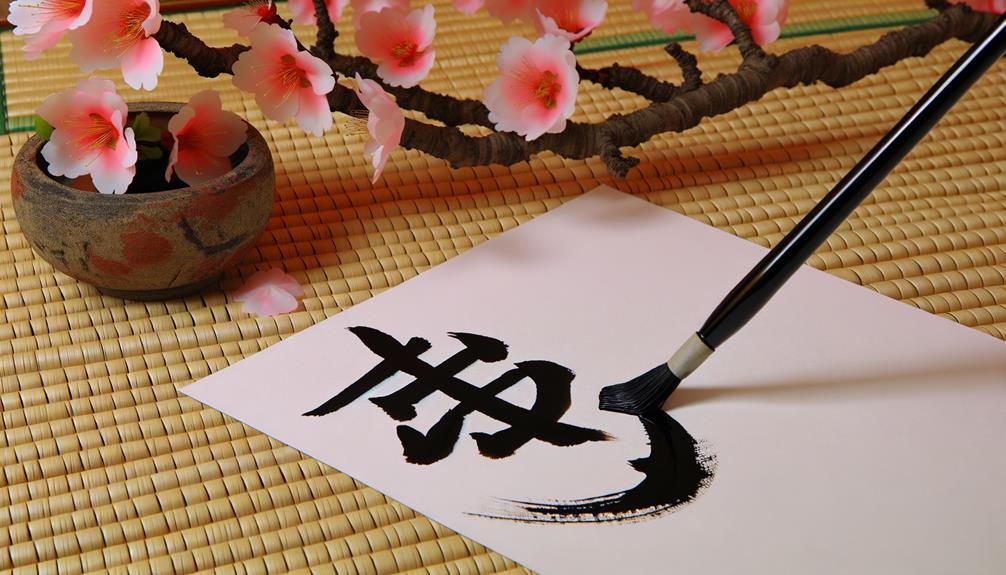
Mastering the art of writing 火 involves understanding its structure and stroke order, which are fundamental in achieving its correct and aesthetically pleasing form.
The character 火, representing ‘fire,’ consists of four strokes that must be executed in a specific sequence to maintain balance and proportion.
- First Stroke: Start with a brief diagonal line from the top left to the bottom right.
- Second Stroke: Draw a lengthier diagonal line from the top right to the bottom left, intersecting the first stroke.
- Third Stroke: Add a vertical line through the point of intersection, extending slightly below the crossing point.
- Fourth Stroke: Finish with a small, horizontal stroke at the center bottom, creating the ‘flames’ effect.
Comprehending these steps guarantees precision and fluency in writing 火, embodying its symbolic significance.
Conclusion
Coincidentally, the kanji character for fire (火) not only captures the element’s physical presence but also embodies a rich tapestry of historical, cultural, and linguistic significance.
From its mythological roots to its prominence in traditional festivals and calligraphy, fire holds a multifaceted role in Japanese society.
The complexity of 火 extends beyond mere symbolism, becoming integral to communication and artistic expression.
Therefore, understanding this character reveals deeper insights into Japan’s cultural and linguistic heritage.

